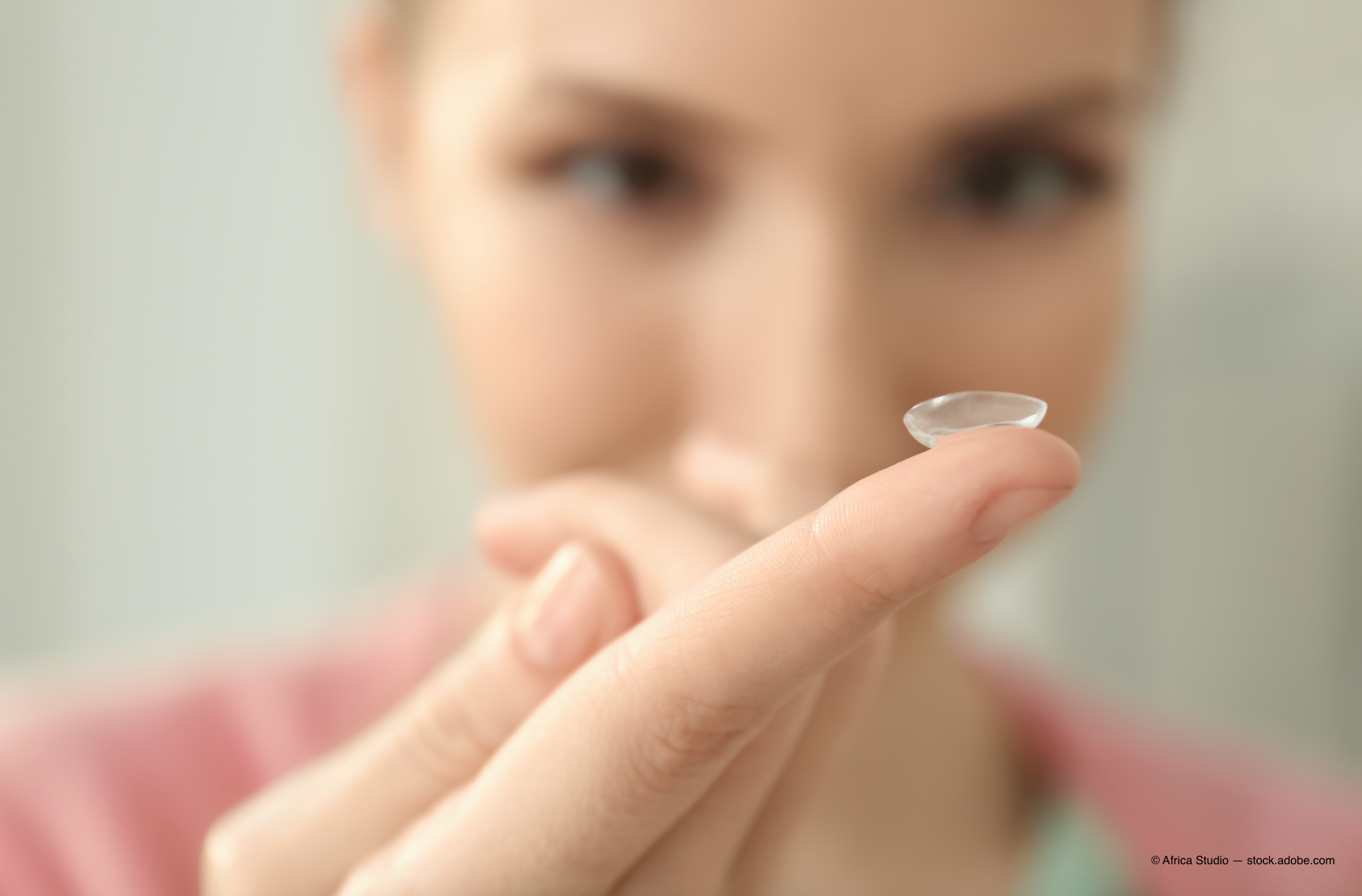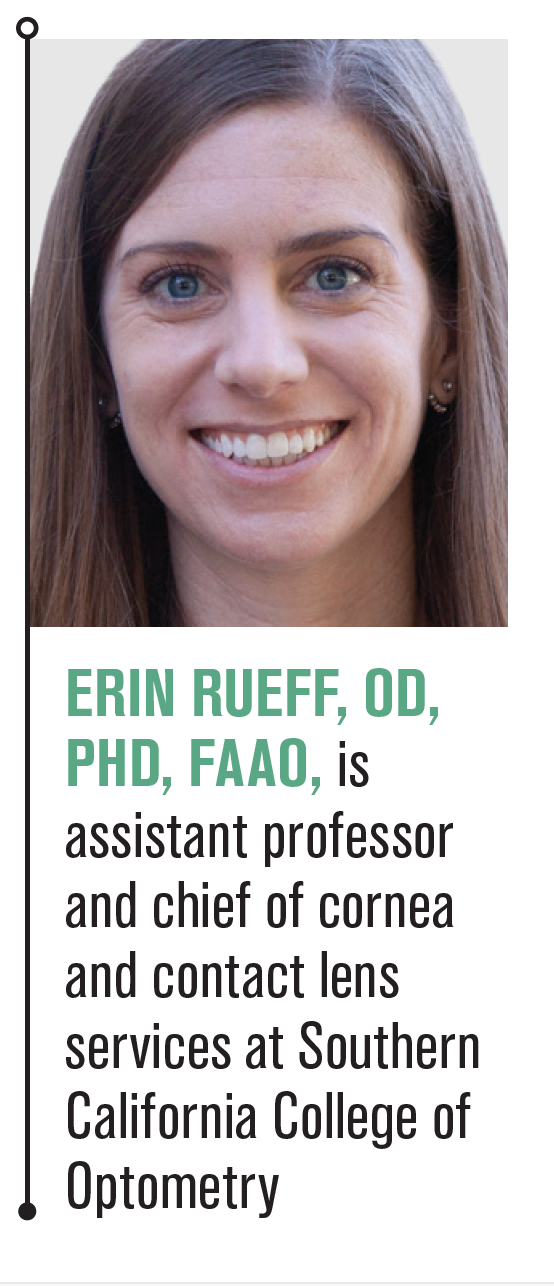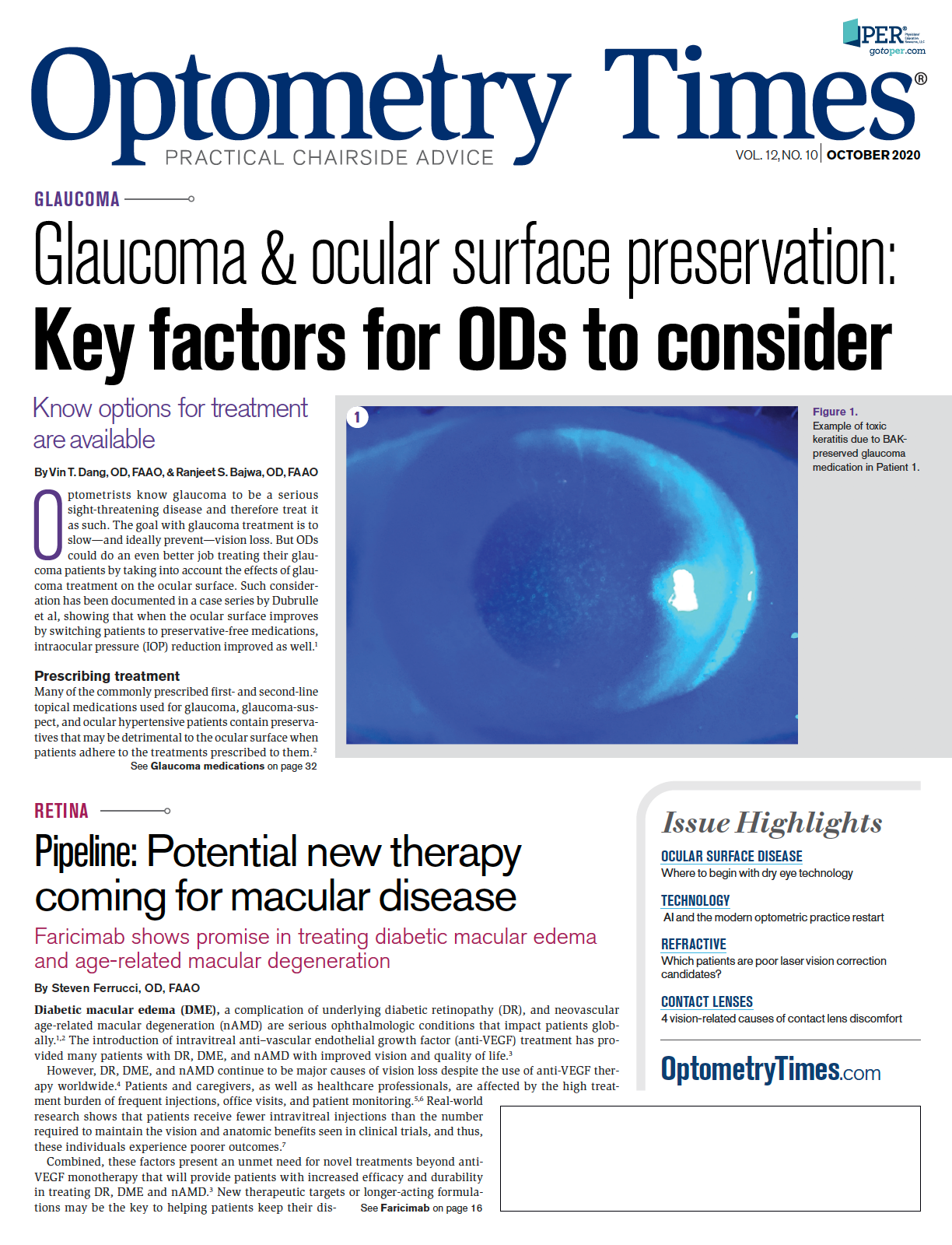4 vision-related causes of contact lens discomfort
Dry eye or ocular surface disease is not the only reason patients drop out of contact lens wear


Discomfort leads many patients to decrease or discontinue contact lens wear. While most discomfort treatment strategies focus on addressing the ocular surface or lens fit, some perceived discomfort is caused by vision-related factors associated with contact lens wear. This article will help the OD recognize factors most likely to be contributing to contact lens visual discomfort and offer solutions.
Contact lens discomfort is the primary reason patients become dissatisfied with and discontinue contact lens wear.1,2
Discomfort due to dry eye
It is easiest to attribute symptoms of discomfort to contact-lens-induced dryness. Symptoms related to discomfort are similar to dry eye, but the symptom profile is one of the few features that uncomfortable contact lens wearers and general dry eye patients share. The epidemiology of contact lens discomfort, for instance, does not follow that of general dry eye.3,4 Contact lens discomfort, unlike dry eye, is not associated with age or gender.3-5 As well, clinical signs that typically indicate dry eye are not correlated with discomfort.4,6,7
Still, the majority of treatment strategies devised for uncomfortable contact lens wearers focus on the ocular surface and contact lens fit.8
Not surprisingly then, these discomfort treatments that assume a dryness cause are often ineffective. When ODs fail to adequately address their patients’ discomfort complaints, patients are forced to resort to the most utilized discomfort self-treatment: decreased or discontinued contact lens wear.1,2,9
4 WAYS TO GO BEYOND OCULAR SURFACE
While uncomfortable contact lens wearers share symptoms with patients suffering from general dry eye, they also share symptoms with patients experiencing visual discomfort associated with vergence and accommodative fatigue, over or under-refractive correction, and general asthenopia.10,11
Asthenopic symptoms caused by vision-related causes can be easily confused by those associated with ocular surface concerns,11 making it important to differentiate causation.
Acknowledging how symptoms associated with vision-related fatigue affect contact lens discomfort is crucial to better understanding and effectively treating uncomfortable contact lens wearers. A recent study of new contact lens wearers, for instance, found that the primary reason for dropout in these neophytes was dissatisfaction with vision.12
This article will outline 4 vision-related concerns to consider when treating discomfort in your contact lens wearers.
Related: Safety and efficacy of myopia progression therapies in children
1 OVERCORRECTED MYOPIA
An extra 0.25 D or 0.50 is tempting to add to a prescription. It can give the patient an extra bump in distance clarity. Remember, however, that extra myopic correction will also lead to increased accommodative demand. Especially for a contact lens prescription that is not accurately vertexed, this could lead to unnecessary fatigue at near, even when vision is clear at all distances.
When trouble-shooting uncomfortable contact lens wearers, trial small amounts of plus power in the distance. If plus power does not degrade their distance vision, consider incorporating that power into the contact lens prescription in order to eliminate accommodative fatigue.
Related: Managing the astigmatic patient with contact lenses
2 UNCORRECTED ASTIGMATISM
ODs under-prescribe toric contact lenses for their astigmatic patients. While about 50 percent of all soft contact lens wearers have astigmatism of 0.75 D or greater, only about 25 percent of all soft contact lens wearers are fitted in toric lenses.13 There is a perception that toric soft lenses take more time to fit or patients with low amounts of astigmatism do not need a toric lens to achieve acceptable vision.
Both of these assumptions are wrong. There is no difference in the time required to fit soft spherical contacts lenses compared to soft toric lenses.14 Most importantly when considering visual discomfort, patients subjectively prefer vision with toric correction, even in low amounts, compared to spherical correction.15 Induced astigmatism has been shown to be associated with symptoms of asthenopia.11 As well, there is evidence that full astigmatic correction improves symptoms associated with visual discomfort.14
All of these facts underline the importance of prescribing toric options for all patients who have astigmatism of 0.75 D or more, especially if they report discomfort with spherical correction. Even if a low toric patient has historically had success with spherical lenses, trialing a toric lens that maximally corrects her refractive error could eliminate discomfort associated with under-corrected astigmatism.
Related: Antidepressant use, age, health linked to abnormal binocular vision
3 UNACKNOWLEDGED BV DISORDERS
While discomfort symptoms are similar to dry eye, they are also similar to symptoms associated with binocular vision and accommodative disorders.
In fact, surveys that assess these groups of seemingly unrelated conditions—dry eye and binocular vision disorders—ask almost identical questions and have been shown to produce correlated symptoms scores.10 Symptoms like blurry/changeable vision, end of day fatigue, and eyestrain are reported by people who suffer from both groups of disorders.
When one considers the increased accommodative and vergence demands experienced by myopic contact lens wearers,16 it is easy to understand how a patient may experience symptoms associated with binocular vision and accommodative strain that he does not experience when corrected with spectacles.
Binocular vision disorders are something ODs often associate with pediatric populations, but it is important to remember that about one third of the adult population has a binocular vision or accommodative disorder.
Uncovering binocular vision abnormalities in uncomfortable contact lens wearers does not require a time-intensive sensorimotor exam. A simple screening with cover test at distance and near, near point of convergence evaluation, and/or vergence range measurements could help uncover signs that vergence or accommodative strain may be contributing to symptoms of discomfort. These findings can start you down the path of treating the binocular vision concern instead of focusing solely on the contact lens.
Related: Surgical, medical approaches making waves in presbyopia
4 Emerging presbyopia
While it may feel like presbyopic symptoms appear suddenly, accommodative decline associated with presbyopia happens gradually throughout the lifetime. From the ages of 20 to 40 years, for instance, accommodative amplitude decreases by approximately 5.00 D.17 While patients may not experience noticeable near blur in their mid- or late-thirties, they may experience fatigue after long periods of near work or find it uncomfortable to sustain near work. In early and emerging presbyopes, it has been shown that ill-sustained accommodation (not accommodative insufficiency, infacility, or vergence concerns) are the primary cause of asthenopic symptoms.18
Emerging presbyopic symptoms may affect contact lens wearers, specifically, in 2 primary ways.
First, as mentioned above, myopic contact lens wearers have to accommodate more in contact lenses compared to spectacles. The increase in accommodative demand when corrected with contact lenses may cause enough asthenopia that a wearer discontinues contact lens wear.
Second, myopic spectacle wearers can easily look under their lenses when reading in order to alleviate accommodative fatigue. These patients may not even realize they are doing this.
Both situations could lead a myopic, early presbyopic contact lens wearer to falsely assume the contact lens was causing the symptoms of discomfort.
To address the patient’s early presbyopic symptoms and to avoid unnecessary contact lens dropout, consider fitting uncomfortable, emerging presbyopes in a multifocal contact lens. Similar to toric lenses, multifocals are woefully underused by eye care providers. Only about half of presbyopic-aged contact lens wearers use a multifocal contact lens.19 So, it is unlikely that many practitioners are considering multifocal options for early and emerging presbyopes. There is evidence, however, that this age group may benefit from or prefer a multifocal contact lens. Compared to younger contact lens wearers, uncomfortable contact lens wearers approaching presbyopia (age 30 to 35 years) have been shown to have increased comfort and preference for multifocal contact lenses.20
If the patient is approaching presbyopia and reporting discomfort symptoms that are also associated with accommodative fatigue, consider trialing a low-powered multifocal. Of course, multifocal contact lenses come with challenges. Patients may notice distance blur or glare around lights, among other symptoms. Educating patients before they experience these symptoms and discussing why a multifocal lens may alleviate their symptoms will help them move through the adaptation process. Then, the OD can determine if a lens that addresses their accommodative fatigue can alleviate their discomfort.
When managing contact lens discomfort, don’t stop at the surface. Once you have confirmed that dryness and lens fit are optimal, consider how the visual system and symptoms associated with visual discomfort may be affecting your patient’s comfort. Acknowledging the ocular surface, lens fit, and the entire visual system is the key to completely and thoroughly assessing and managing discomfort in contact lens wearers.
More from October 2020's issue: Lifestyle interventions to prevent dry eye disease
References
1. Pritchard N, Fonn D, Brazeau D. Discontinuation of Contact Lens Wear: A Survey. Int Contact Lens Clin. 1999 Nov;26(6):157-62.
2. Richdale K, Sinnott LT, Skadahl E, Nichols JJ. Frequency of and Factors Associated with Contact Lens Dissatisfaction and Discontinuation. Cornea. 2007 Feb;26(2):168-74.
3. Chalmers RL, Begley CG. Dryness symptoms among an unselected clinical population with and without contact lens wear. Cont Lens Anterior Eye. 2006 Mar;29(1):25-30.
4. Young G, Chalmers R, Napier L, Kern J, Hunt C, Dumbleton K. Soft contact lens-related dryness with and without clinical signs. Optom Vis Sci. 2012 Aug;89(8):1125-32.
5. Truong TN, Graham AD, Lin MC. Factors in contact lens symptoms: evidence from a multistudy database. Optom Vis Sci. 2014 Feb;91(2):133-41.
6. Begley CG, Chalmers RL, Abetz L, Venkataraman K, Mertzanis P, Caffery BA, Snyder C, Edrington T, Nelson, D, Simpson T. The relationship between habitual patient-reported symptoms and clinical signs among patients with dry eye of varying severity. Invest Ophthalmol Vis Sci. 2003 Nov;44(11):4753-61.
7. Pult H, Purslow C, Berry M, Murphy PJ. Clinical tests for successful contact lens wear: relationship and predictive potential. Optom Vis Sci. 2008 Oct;85(10):E924-9.
8. AG G, JJ N. Annual Report on Dry Eye Disesae. Contact Lens Spectrum. 2012:26-30.
9. Dumbleton K, Woods CA, Jones LW, Fonn D. The impact of contemporary contact lenses on contact lens discontinuation. Eye Contact Lens. 2013 Jan;39(1):93-9.
10. Rueff EM, King-Smith PE, Bailey MD. Can Binocular Vision Disorders Contribute to Contact Lens Discomfort? Optom Vis Sci. 2015 Sep;92(9):e214-21.
11. Sheedy JE, Hayes JN, Engle J. Is all asthenopia the same? Optom Vis Sci. 2003 Nov;80(11):732-9.
12. Sulley A, Young G, Hunt C, McCready S, Targett MT, Craven R. Retention Rates in New Contact Lens Wearers. Eye Contact Lens. 2018 Sep;44 Suppl 1:S273-S82.
13. Morgan PB, Efron N, Woods CA, International Contact Lens Prescribing Survey Consortium. An international survey of toric contact lens prescribing. Eye Contact Lens. 2013 Mar;39(2):132-7.
14. Cox SM, Berntsen DA, Bickle KM, Mathew JH, Powell DR, Little BK, Lorenz KO, Nichols JJ. Efficacy of Toric Contact Lenses in Fitting and Patient-Reported Outcomes in Contact Lens Wearers. Eye Contact Lens. 2018 Sep;44 Suppl 1:S296-S9.
15. Berntsen DA, Cox SM, Bickle KM, et al. A Randomized Trial to Evaluate the Effect of Toric Versus Spherical Contact Lenses on Vision and Eyestrain. Eye Contact Lens. 2019;45:28-33.
16. Alpern M. Accommodation and Convergence with Contact Lenses. Am J Optom Arch Am Acad Optom. 1949 Sep;26)9):379-87.
17. Anderson HA, Hentz G, Glasser A, Stuebing KK, Manny RE. Minus-lens-stimulated accommodative amplitude decreases sigmoidally with age: a study of objectively measured accommodative amplitudes from age 3. Invest Ophthalmol Vis Sci. 2008 Jul;49(7):2919-26.
18. Reindel W, Zhang L, Chinn J, Rah M. Evaluation of binocular function among pre- and early-presbyopes with asthenopia. Clin Optom (Auckl). 2018 Jan 4;10:1-8.
19. Morgan PB, Woods CA, Tranoudis IG. International Contact Lens Prescribing in 2016. Contact Lens Spectrum. 2017;32:30-5.
20. Rueff EM, Jones-Jordan LA, Bailey MD. Aspheric Contact Lens Treatment for Symptomatic Non-Presbyopes. The American Academy of Optometry Annual Meeting 2018;Abstract 185269.

Newsletter
Want more insights like this? Subscribe to Optometry Times and get clinical pearls and practice tips delivered straight to your inbox.
2 Commerce Drive
Cranbury, NJ 08512
All rights reserved.